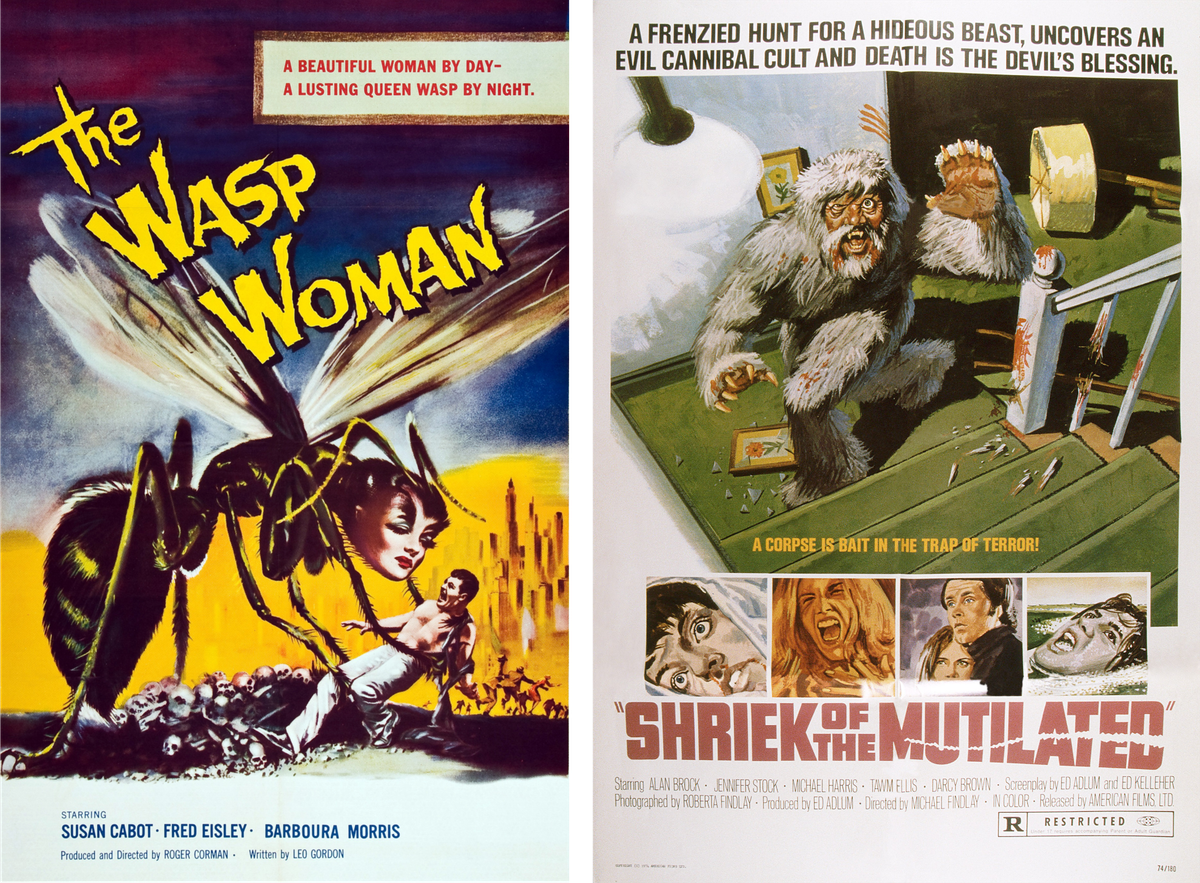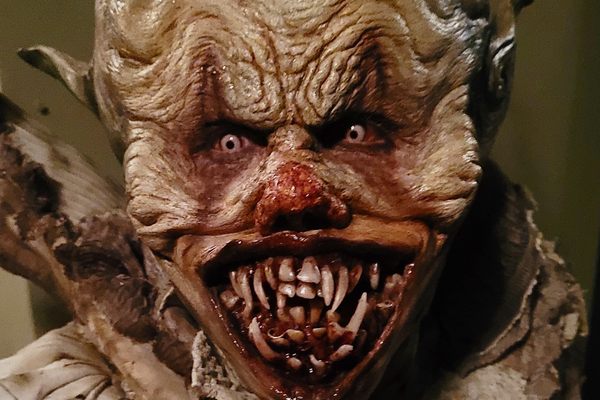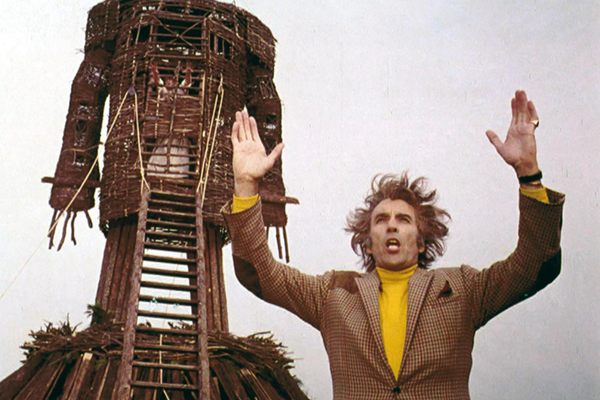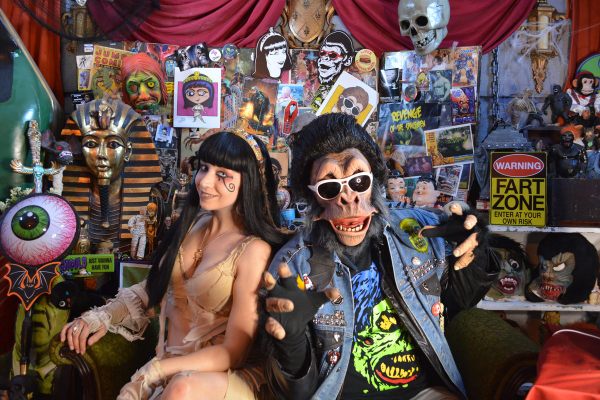
From Elvira to Svengoolie, Local Horror Hosts’ Frightfully Fun History
Every night across the U.S. local horror hosts don masks and costumes to tell jokes and revel in the absurdity of classic horror films.
On Friday nights at 9 p.m. Eastern, two rockabilly monsters appear on a YouTube livestream, broadcasting from their home in Cleveland, Ohio.
“I’m Janet Decay, the Mummy,” says Janet Jay, wearing scraps of white cloth, fishnet stockings, and jet-black hair accented with a gold headband.
“And I’m Grimm Gorri, the Monkey!” Adds James Harmon, dressed in a rubber gorilla mask with a pompadour, sunglasses, and a denim vest covered in pins and spikes. The wall and shelves behind them are decorated with colorful monster masks and knick-knacks.

“And you’re watching,” the duo says in animated unison, “The Mummy and the Monkey’s Hairy Scary Hangout!”
This is a horror host show, a broadcasting format that’s been around since the 1950s. Horror host shows feature zany characters who introduce a B horror movie. They screen the film interspersed with bumper segments, originally to lead in and out of commercial breaks, but now often used to break up the movie and make jokes about it. Today, the format has taken many different forms, from nationally syndicated TV specials to streaming platforms to TikTok.

Tonight, Jay and Harmon are screening a 1978 stinkbomb about a town attacked by killer tigers titled Maneaters Are Loose! Every movie featured on The Mummy and the Monkey’s Hairy Scary Hangout must fulfill two requirements: “It has to be terrible,” says Jay. “And it has to be cheesy.”
Although the movies are awful and the humor is crude, horror hosts function as oddly clad film preservationists, quick to give a biography lesson on classic horror actors like Bela Lugosi, or the plot of a Godzilla movie.
“Horror hosts are curators,” says Jason Hignite, who works in the horror film and convention industry and is a co-founder of the Horror Host Hall of Fame, a ceremonial induction that happens annually at the HorrorHound convention held in Cincinnati, Ohio, or Indianapolis.
“Horror is one of the only genres that has this connection to its past. They present these films that the audience would probably have no reason to otherwise be exposed to: They keep these obscure titles alive. I mean, I’m not really sure where else you’ll see The Wasp Woman or Shriek of the Mutilated.”
Hignite adds that horror host shows are “one of the few things in our culture that are truly, uniquely American.” Although they’ve popped up in other countries such as Australia, the United Kingdom, and Mexico, the origins of the show format started in Los Angeles and quickly spread from coast to coast.

Horror storytelling has been around throughout time, and the concept of a “host” leading an audience through a scary tale predates television.
“Horror and comedy have been consistently popular since film production began in the 1890s,” says Gary Rhodes, a media production and horror scholar at Oklahoma Baptist University, and an editor of Horror Studies, a peer-reviewed academic journal that examines all aspects of the genre.
“Both [comedy and horror] hit us on a gut level, pure emotion. Some viewers appreciate the catharsis they experience from watching horror, knowing deep down, even when scared, that they are safe in the movie theater or their home.”
Rhodes says the horror host concept can be traced to radio programs of the Great Depression, like The Witch’s Tale, which was broadcast from 1931 to 1938.
“Originally, they functioned akin to storytellers around a campfire at night. Horror hosts on the radio also began a wonderful tradition of tempering horror stories with their own brand of comic relief, usually dark humor,” Rhodes says, citing Inner Sanctum as an example.
The Inner Sanctum radio show aired from 1941 to 1952 and was hosted by Raymond Edward Johnson (simply named Raymond on the show), who would pepper every horror story with morbid puns.

That dark humor was a key element to what is credited as the first television horror host—Vampira, portrayed by actress and model Maila Nurmi. Nurmi moved from Astoria, Oregon to Hollywood in the 1940s to pursue a career in show business. Inspired by the Addams Family cartoons drawn by Charles Addams for The New Yorker, Nurmi put together a costume inspired by Morticia for a masquerade ball. A producer for Los Angeles station KABC-TV spotted Nurmi and was struck by an idea for a Saturday night show—Nurmi would create an eerie, vampy character that would host a program that screened old monster movies.
The Vampira Show premiered in 1954 and established the formula duplicated by the many dozens of shows that followed. Vampira would glide down a hallway in a dry ice fog to a spooky but cheaply made set, introduce the night’s film, and crack some jokes, often at the movie’s expense. The Vampira Show was short-lived, appearing from 1954 to 1955 on KABC (and a short stint at rival station KHJ-TV in 1956), but the concept quickly spread.
What helped launch this first wave of horror hosts, Hignite explains, is a syndicated movie package put together by the Screen Gems company starting in the late 1950s.
“It was a set of 52 films, [and] TV stations around the country could purchase them at a cheap rate and then the station would have a movie a week for a whole year,” Hignite says. All the station had to do was find a host to introduce the film.
Sometimes that was someone at the station who would pull double duty. Lisa Clark, a news anchor for KOGO in San Diego, California, also portrayed horror host Moona Lisa, who had a show from 1963 to 1973. KOGO had not only created a cheap program, but also created their own in-house local spooky celebrity.
“It helped these communities create some self-identity,” Hignite says. For “the people that lived in that market—that was their horror host.” Several generations of viewers have fond memories of waiting up late to watch their beloved local host.

One of the biggest regional hits, and a predecessor to Jay and Harmon’s show, was Cleveland’s Ghoulardi, played by Ernie Anderson (father of director Paul Thomas Anderson), a beatnik ghoul who had a show from 1963 to 1966. The show was so popular that police allegedly reported a dip in juvenile crime when the show aired on Friday nights.
Hignite, who lived in Ohio, but now lives in Shelbyville, Indiana, says Ohio has a rich horror host scene that goes back decades. He admits the reason is a “bit of a mystery” to him, but he speculates the early success of Ghoulardi’s devoted viewership inspired others.
“Ohio has had more horror hosts per capita than any other state by far,” Hignite says. “I was lucky in that I lived in the borderlands, so I could watch Sammy Terry of Indianapolis, Dr. Creep out of Dayton, and Fritz the Night Owl out of Columbus.”
Other hosts found success around the country. John Zacherele, who went by “Roland” and later “Zacherely,” had a following in the Philadelphia and New York markets as a creepy undertaker from 1957 through the 1960s. He created a hit novelty song for his show in 1958, “Dinner with Drac.”

The host with the longest career is Dick Dystel aka Count Gore De Vol, host of Creature Feature, which premiered in the Washington D.C. market in 1973. He was the first host to create his own website and make the move online in 1998, where he reached thousands of digital viewers. Dystel, now 76, still appears as the Count at movie screenings in Maryland and at horror conventions.
Philadelphia was also home to the cleverly named Saturday Night Dead, which aired on the local NBC affiliate right after Saturday Night Live. It was hosted by Karen Scioli as the sultry Stella, “Daughter of Desire,” and ran from 1984 to 1990. Scioli won a local Emmy for her character.
Jay and Harmon met on the set of a different horror host show, where Jay was an actress and Harmon worked behind the scenes. They decided to create The Mummy and the Monkey’s Hairy Scary Hangout together in 2014. Their friendship turned to romance, and marriage followed. Like most contemporary hosts, they view their show as more of a creative outlet than a career.
“It’s a passion project of ours, we do other stuff to pay the bills,” says Jay. She resells items she thrifts (she even ran a thrift store for a while called The Mummy and The Monkey’s Thrift Crypt), and Harmon works as a graphic and toy designer.
As for commercially successful hosts, Jay points out what she calls “the Big Three”—Elvira, Svengoolie, and Joe Bob Briggs.
In 1981, Los Angeles station KHJ-TV attempted to revive The Vampira Show. Nurmi was told a new, younger actress would play Vampira, while Nurmi would have a role as Vampira’s mother, as well as a producer credit and a royalty paycheck. Negotiations fell apart and the studio simply changed the name of the character, played by Cassandra Peterson, to Elvira. Nurmi attempted to sue the station and Peterson, but the court ruled that “likeness means actual representation of another person’s appearance, and not simply close resemblance.”
Elvira’s Movie Macabre created an ’80s icon and was one of the first horror host shows to find national syndication, as well as tapping into the quickly growing home VHS market. Elvira was merchandised on pinball games and T-shirts, and she became the spokesperson for Coors and Mug Root Beer ad campaigns.
Svengoolie, the beloved horror host of Chicago, was originally played by Jerry Bishop in the 1970s. Like Ghoulardi before him, Bishop’s Svengoolie played on the counterculture and was a wild, hippie ghoul. Richard Koz, who now plays the character, got his start working with Bishop, who passed away in 2013.

“He took me under his wing as a writer and voice actor on his show,” Koz says. “When the original Svengoolie show was canceled, I went with him to WMAQ radio. During that time, a friend of his at another TV station asked if he might do Svengoolie again as just a summer replacement type thing.” Bishop passed, but Koz, with his blessing, performed as “Son of Svengoolie” in 1979. After shopping the show around, Koz found a home for Son of Svengoolie at Chicago’s WFLD.
“It was also Jerry’s idea that I just use the name Svengoolie when I went to the current company I work for. He said, ‘You’re all grown up, just be Svengoolie!’” Koz says. Svengoolie is now nationally syndicated on the MeTV channel.
One gag that’s survived throughout Svengoolie’s history is the barrage of rubber chickens thrown at the host when he tells a terrible one-liner. “I have kept up on the tradition and we’ve heard that we have often been responsible for stores selling out of them.”
Koz says horror hosts are “truly a sort of brother or sisterhood. Elvira has always been very kind to us. The great Zacherley [who passed away in 2016] liked what I do. I’ve had lunch with Count Gore De Vol, and any time spent with my friend Joe Bob Briggs and his co-host, Darcy the Mail Girl has always been great.”
Joe Bob Briggs, a “redneck Texan” character, is a horror community favorite, played by John Irving Bloom. His first show, Joe Bob’s Drive-in, premiered in 1986 on The Movie Channel. He now hosts The Last Drive-in with Joe Bob Briggs on Shudder.
As cable access stations began to spread in the 1970s and ’80s, opportunities beyond network TV made it easier for people to dream up their own shows. Dale Wamboldt, aka Dr. Destruction of Kenosha, Wisconsin, has been hosting his show, Dr. Destruction’s Crimson Theatre, since 2001, which appears on the Kenosha Community Media cable access channel, among other platforms.
His character spun out of his rock band, Die Monster Die, and he’s a well-known character in Kenosha, fully embracing his creepy persona. His car used to be a hearse, and now he cruises in his “Halloween Machine” (a van with a mural of him painted on the side) wearing his stark black and white makeup, skeletal gloves, and top hat.

“The connection with the Kenosha community as the ‘horror guy’ is my favorite part of hosting,” says Wamboldt. He grew up watching Jerry Bishop’s Svengoolie and a Milwaukee host named Dr. Cadaverino, played by Jack DuBlon on WITI from 1964 to 1977.
Wamboldt runs his own haunted house, Dr. Destruction’s Haunted Manor, which is on the grounds of the Jerry Smith Pumpkin Farm, and in 2004 ran for mayor of Kenosha in character. He lost, but Mayor John Antaramian (who won the mayoral bid that year) graciously appeared on an episode of Crimson Theatre.
Some of Wamboldt’s former co-stars went on to start their own shows. If Ohio has the highest capita of hosts by state, Kenosha, with a population of just under 100,000, has the highest by city (the subject of a new documentary, I’m Your Host). Crimson Theatre is currently joined by Kenosha-based shows Hexen Arcane, Nightmare Cinema, and Storm’s Eclectic Realm.
The first movie Wamboldt screened on Crimson Theatre in 2001 is a horror host classic, Plan 9 from Outer Space, the 1957 flop directed by Ed Wood. The film featured Vampira in a supporting role and is sometimes labeled “the worst movie ever made.” But Jay and Harmon, who have also screened the movie, distinguish it as the “good bad” they’re looking for and not an actually bad movie.
“Plan 9 is one of the better ones,” Jay says. “It’s caviar,” Harmon adds. He gives 1961’s The Beast of Yucca Flats as an example of an unbearably bad movie. “Plan 9 is a masterpiece compared to it. We threaten to show it if people don’t behave.” Jay and Harmon cite another favorite as Night of the Living Dead, George Romero’s 1968 zombie classic and, along with Plan 9, one of the most frequent horror host picks.
“It’s a Halloween classic and it still holds up,” Jay says.

The Internet gave horror hosts even more options, and contemporary hosts typically try to reach audiences on multiple platforms—most have a presence on YouTube or online sites like The Monster Channel, which airs host programming around the clock.
The Mummy and the Monkey’s Hairy Scary Hangout hits the trifecta of platforms. They began live-streaming on YouTube a few years ago, and they say they enjoy being able to interact live with their viewers who leave comments in the chat. The show is simulcast to the cable access Public Media Network in Kalamazoo and later screens on network station WRTN in Nashville.
The changing nature of how we absorb media is something being considered by a new horror host show, Stro’s SINister SINema, which premiered earlier this year.
“The younger generations, it’s all short format now, it’s got to be grabbing—they don’t want to sit and take the time. They don’t necessarily appreciate what we appreciate about horror,” says the show’s writer and director, Ronald Rossman, who grew up watching Elvira and Joe Bob Briggs.
The show is based in York, South Carolina, and stars Rob Kellum as Papa Stro, a warlock, and Chuck Sloan as a werewolf named Wolfgang. The characters comment over the movie (much like another popular show, considered to be a variation on the horror host idea, Mystery Science Theater 3000).
Episodes of Stro’s SINister SINema are available to purchase and stream on Amazon, trailers are uploaded to YouTube, and shorter snippets are made for TikTok, Instagram, and Rumble. As the show moves into season two next year, Rossman says he’s reworking the show format with more bite-size pieces, and a larger monster ensemble of potential social media stars. The new tone parodies ’80s sitcom cliches, and the cast includes a social media monster influencer named Cindy Clops (played by Daphne Reeder), a cyclops with platforms on “Monstergram” and “Clip Clop.
“We’re still learning, still developing,” Rossman says. “We’re trying to find the right mix—I don’t know that we’ve found it yet.”

“I think people like having someone there to join them during the movie to keep them company, in a way, and share their love of horror films,” Koz says on the appeal of Svengoolie and other hosts. “Someone who is entertaining them and actually talking to them. People make a connection to us, we become just like their friends.”
What makes a good horror host, one worthy of being inducted into the Horror Host Hall of Fame?
“I’ve seen a lot of horror hosts come and go,” Hignite says. “Those who stick around and get a following, it’s because it’s something personal to them. You got to spend some time on the craft, the writing, you got to develop your character and a bit of mythos around the show.”
Hignite adds that high production value isn’t required, and that “schlock” adds to the vibe of the show. He mentions Watson Davis, aka Sivad, a host out of Memphis from 1967 to 1972, as an example.
“He had these fangs made of rubber and they just sort of flopped around and impeded his ability to talk, but it was part of his charm,” Hignite says.
After the original horror host, Malia Nurmi, died in 2008, Hignite helped organize a tribute to Vampira at the 2010 HorrorHound convention in Indianapolis, and over 80 horror hosts attended to pay their respects. That led to the creation of the Horror Host Hall of Fame, a website and ceremony, the following year. Vampira and Zacherley were inducted, with over a hundred horror hosts in attendance. Hignite believes it was the largest assembly of hosts ever.

Svengoolie, Elvira, Joe Bob Briggs, and dozens of lesser-known hosts were added in the years that followed. Hignite says the ceremony is to celebrate the hosts of yesteryear as well as to “encourage the next generation.”
This year the ceremony took place on August 19. It was like any other award ceremony, except the emcee was Slash, the werewolf host of Slash’s Graveyard Tales, and the audience consisted of ghouls, vampires, zombies, mad scientists, and other creatures of the night.
Jay and Harmon’s Janet Decay and Grimm Gorri characters and Wamboldt’s Dr. Destruction were among the 2023 inductees, cementing their role of sharing some of the best/worst horror films in the genre’s long history.
“We never thought it would happen, we were honored,” Jay says as Harmon nods in agreement. She says her favorite part of being a horror host mummy is providing viewers with some entertainment after a long week.
“I think it’s great knowing that out of all the craziness in the world, whatever they’re going through or struggling with, it’s a little bit of a distraction,” Jay says. “It’s something fun—we can watch a movie together and laugh at it. It takes your mind away from the crap going on in the real world.”














Follow us on Twitter to get the latest on the world's hidden wonders.
Like us on Facebook to get the latest on the world's hidden wonders.
Follow us on Twitter Like us on Facebook